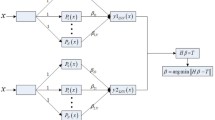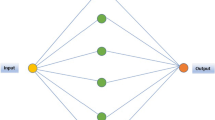Abstract
To provide a new numerical algorithm for solving elliptic partial differential equations (PDEs), the Legendre neural network (LNN) and improved extreme learning machine (IELM) algorithm are introduced to propose a Legendre improved extreme learning machine (L-IELM) method, which is applied to solving elliptic PDEs in this paper. The product of two Legendre polynomials is chosen as basis functions of hidden neurons. Single hidden layer LNN is used to construct approximate solutions and its derivatives of differential equations. IELM algorithm is used for network weights training, and the algorithm steps of the proposed L-IELM method are summarized. Finally, in order to evaluate the present algorithm, various test examples are selected and solved by the proposed approach to validate the calculation accuracy. Comparative study with the earlier methods in literature is described to verify the superiority of the presented L-IELM method. Experiment results show that the proposed L-IELM algorithm can perform well in terms of accuracy and execution time, which in addition provides a new algorithm for solving elliptic PDEs.









Similar content being viewed by others
References
Abdulla MB, Costa AL, Sousa RL (2018) Probabilistic identification of subsurface gypsum geohazards using artificial neural networks. Neural Comput Appl 29(12):1377–1391
Arndt O, Barth T, Freisleben B, Grauer M (2005) Approximating a finite element model by neural network prediction for facility optimization in groundwater engineering. Eur J Oper Res 166(3):769–781
Beltzer AI, Sato T (2003) Neural classification of finite elements. Comput Struct 81(24–25):2331–2335
Chedhou JC, Kyamakya K et al (2009) Solving stiff ordinary and partial differential equations using analog computing based on cellular neural networks. In: 2nd International workshop on nonlinear dynamics and synchronization, Klagenfurt, vol 4, p 213
Deng J, Yue ZQ, Tham LG et al (2003) Pillar design by combining finite element methods, neural networks and reliability: a case study of the Feng Huangshan copper mine, China. Int J Rock Mech Min Sci 40(4):585–599
Deng W, Zhao H, Yang X et al (2017a) Study on an improved adaptive PSO algorithm for solving multi-objective gate assignment. Appl Soft Comput 59:288–302
Deng W, Yao R, Zhao H et al (2017b) A novel intelligent diagnosis method using optimal LS-SVM with improved PSO algorithm. Soft Comput. https://doi.org/10.1007/s00500-017-2940-9
Deng W, Zhao H, Zou L et al (2017c) A novel collaborative optimization algorithm in solving complex optimization problems. Soft Comput 21:4387–4398
Deng W, Zhang S, Zhao H et al (2018) A novel Fault diagnosis method based on integrating empirical wavelet transform and fuzzy entropy for motor bearing. IEEE Access 6:35042–35056
Deng W, Junjie X, Zhao H (2019) An improved ant colony optimization algorithm based on hybrid strategies for scheduling problem. IEEE Access 7:20281–20292
Dwivedi AK (2018) Artificial neural network model for effective cancer classification using microarray gene expression data. Neural Comput Appl 29(12):1545–1554
Esposito A, Marinaro M, Oricchio D, Scarpetta S (2000) Approximation of continuous and discontinuous mappings by a growing neural RBF-based algorithm. Neural Netw 13(6):651–665
Haykin S (2002) Neural networks: a comprehensive foundation. Pearson Education, Singapore
He S, Reif K, Unbehauen R (2000) Multilayer neural networks for solving a class of partial differential equations. Neural Netw 13(3):385–396
Huang G-B, Chen L (2007) Convex incremental extreme learning machine. Neurocomputing 70(16):3056–3062
Huang G-B, Chen L (2008) Enhanced random search based incremental extreme learning machine. Neurocomputing 71(16):3460–3468
Huang G-B, Zhu Q-Y, Siew C-K (2006a) Extreme learning machine: theory and applications. Neurocomputing 70(1):489–501
Huang G-B, Chen L, Siew C-K (2006b) Universal approximation using incremental constructive feedforward networks with random hidden nodes. IEEE Trans Neural Netw 17(4):879–892
Huang G-B, Zhou H, Ding X et al (2012) Extreme learning machine for regression and multiclass classification. IEEE Trans Syst Man Cybernet Part B Cybernet 42(2):513–529
Jianyu L, Siwei L, Yingjian Q, Yaping H (2002) Numerical Solution of differential equations by radial basis function neural networks. In: Proceedings of the 2002 international joint conference on neural networks, vol 1, pp 773–777
Jianyu L, Siwei L et al (2003) Numerical solution of elliptic partial differential equation using radial basis function neural networks. Neural Netw 16(5–6):729–734
Jilani H, Bahreininejad A, Ahmadi MT (2009) Adaptive finite element mesh triangulation using self-organizing neural networks. Adv Eng Softw 40(11):1097–1103
Jinfu L, Zhi G (2003) Numerical solution of partial differential equation, 2nd edn. Tsinghua University Press, Beijing
Junfei Q, Wei Z (2018) Dynamic multi-objective optimization control for wastewater treatment process. Neural Comput Appl 29(11):1261–1271
Koroglu S, Sergeant P, Umurkan N (2010) Comparison of analytical, finite element and neural network methods to study magnetic shielding. Simul Model Pract Theory 18(2):206–216
Lagaris IE, Likas A, Fotiadis DI (1998) Artificial neural networks for solving ordinary and partial differential equations. IEEE Trans Neural Netw 9(5):987–1000
Leshno M, Lin Vladimir Ya et al (1993) Multilayer feedforward networks with a nonpolynomial activation function can approximate any function. Neural Netw 6(6):861–867
Li X, Ouyang J, Li Q, Ren J (2010) Integration wavelet neural network for steady convection dominated diffusion problem. In: 3rd international conference on information and computing vol 2, no 2, pp 109–112
Mai-Duy N, Tran-Cong T (2001) Numerical solution of differential equations using multiquadric radial basis function networks. Neural Netw 14:185–199
Mall S, Chakraverty S (2017) Single layer Chebyshev neural network model for solving elliptic partial differential equations. Neural Process Lett 45(3):825–840
Manevitz L, Bitar A, Givoli D (2005) Neural network time series forecasting of finite-element mesh adaptation. Neurocomputing 63:447–463
Manganaro G, Arena P, Fortuna L (1999) Cellular neural networks: chaos. complexity and VLSI processing. Springer, Berlin, pp 44–45
Muzhou H, Xuli H (2010) Constructive approximation to multivariate function by decay RBF neural network. IEEE Trans Neural Netw 21(9):1517–1523
Muzhou H, Xuli H (2011) The multidimensional function approximation based on constructive wavelet RBF neural network. Appl Soft Comput 11(2):2173–2177
Muzhou H, Xuli H (2012) Multivariate numerical approximation using constructive L-2(R) RBF neural network. Neural Comput Appl 21(1):25–34
Muzhou H, Xuli H, Yixuan G (2009) Constructive approximation to real function by wavelet neural networks. Neural Comput Appl 18(8):883–889
Muzhou H, Taohua L, Yunlei Y et al (2017) A new hybrid constructive neural network method for impacting and its application on tungsten price prediction. Appl Intell 47(1):28–43
Muzhou H, Yunlei Y, Taohua L et al (2018) Forecasting time series with optimal neural networks using multi-objective optimization algorithm based on AICc. Front Comput Sci 12(6):1261–1263
Ramuhalli P, Udpa L, Udpa SS (2005) Finite element neural networks for solving differential equations. IEEE Trans Neural Netw 16(6):1381–1392
Ronghua L (2010) Numerical solution of partial differential equation, 2nd edn. Higher Education Press, Beijing
Sun H, Hou M, Yang Y et al (2018) Solving partial differential equation based on Bernstein neural network and extreme learning machine algorithm. Neural Process Lett. https://doi.org/10.1007/s11063-018-9911-8
Tohidi E (2015) Application of Chebyshev collocation method for solving two classes of non-classical parabolic PDEs. Ain Shams Eng J 6(1):373–379
Tsoulos IG, Gavrilis D, Glavas E (2009) Solving differential equations with constructed neural networks. Neurocomputing 72(10–12):2385–2391
Vigo-Aguiar J, Higinio R, Clavero C (2017) A first approach in solving initial-value problems in ODEs by elliptic fitting methods. J Comput Appl Math 318:599–603
Wang Y, Liu M, Bao Z et al (2018) Stacked sparse autoencoder with PCA and SVM for data-based line trip fault diagnosis in power systems. Neural Comput Appl. https://doi.org/10.1007/s00521-018-3490-5
Yuanyuan J, Xiaogang P, Zhenyu Z et al (2018) Learning sparse partial differential equations for vector-valued images. Neural Comput Appl 29(11):1205–1216
Zhao H, Sun M, Deng W et al (2017) A new feature extraction method based on EEMD and multi-scale fuzzy entropy for motor bearing. Entropy 19(1):14
Zhao H, Yao R, Ling X et al (2018) Study on a novel fault damage degree identification method using high-order differential mathematical morphology gradient spectrum entropy. Entropy 20(9):682
Ziemianski L (2003) Hybrid neural network finite element modeling of wave propagation in infinite domains. Comput Struct 81(8–11):1099–1109
Zolfaghari R, Shidfar A (2013) Solving a parabolic PDE with nonlocal boundary conditions using the Sinc method. Numer Algorithms 62(3):411–427
Funding
This study was funded by the National Natural Science Foundation of China (Grant numbers 61375063, 61271355, 11301549 and 11271378).
Author information
Authors and Affiliations
Corresponding author
Ethics declarations
Conflict of interest
The authors declare that they have no conflict of interest.
Ethical approval
All procedures performed in studies involving human participants were in accordance with the ethical standards of the institutional and/or national research committee and with the 1964 Helsinki Declaration and its later amendments or comparable ethical standards.
Human and animal rights
This article does not contain any studies with animals performed by any of the authors.
Informed consent
Informed consent was obtained from all individual participants included in the study.
Additional information
Communicated by V. Loia.
Publisher’s Note
Springer Nature remains neutral with regard to jurisdictional claims in published maps and institutional affiliations.
Rights and permissions
About this article
Cite this article
Yang, Y., Hou, M., Sun, H. et al. Neural network algorithm based on Legendre improved extreme learning machine for solving elliptic partial differential equations. Soft Comput 24, 1083–1096 (2020). https://doi.org/10.1007/s00500-019-03944-1
Published:
Issue Date:
DOI: https://doi.org/10.1007/s00500-019-03944-1




